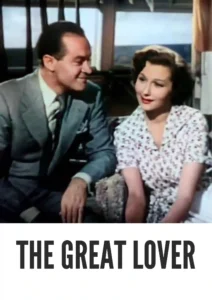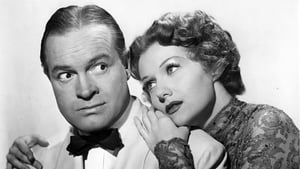Contact: info@alwanfilm.com
Video Sources 0 Views

Synopsis
Review: The Great Lover 1949 Colorized – A Classic Romantic Comedy Revisited

Introduction
In the golden age of Hollywood, the romantic comedy was a genre that captivated audiences with its blend of wit, charm, and escapism. Among the many films of this era, “The Great Lover” (1949) stands out as a delightful entry that combines humor with a touch of suspense. Starring the legendary Bob Hope, this film not only showcases his comedic genius but also offers a glimpse into the cinematic trends of the late 1940s. In this article, we will explore “The Great Lover” in detail, examining its story, cast, reception, and the significance of its place in Hollywood history.
Check The Full Colorized Movies List
Check Our Colorized Movies Trailer Channel
Understanding The Great Lover 1949 Colorized: Director, Cast, and Genre
“The Great Lover” was directed by Alexander Hall, a filmmaker known for his work in the comedy genre during the 1930s and 1940s. Hall had a knack for directing lighthearted films that entertained audiences without demanding too much introspection. In “The Great Lover,” Hall’s direction emphasizes the film’s comedic elements while allowing the charm of its leading man to shine through.
Bob Hope, one of the most iconic comedians of the 20th century, leads the cast in the role of Freddie Hunter, a hapless scoutmaster who finds himself entangled in a web of mistaken identity and international intrigue. Hope’s performance is the cornerstone of the film, as his quick wit and impeccable timing elevate the material, turning what could have been a straightforward comedy into a memorable cinematic experience.
Accompanying Hope are a talented supporting cast, including Rhonda Fleming as the glamorous and mysterious Duchess Alexandria and Roland Young as the conniving villain C.J. Dabney. Each actor brings their own unique flair to the film, contributing to its overall appeal. The chemistry between the actors, particularly between Hope and Fleming, adds a layer of romantic tension that enhances the comedic narrative.
The genre of “The Great Lover” can be categorized as a romantic comedy with elements of adventure and suspense. While the primary focus is on humor and romance, the film also incorporates a subplot involving a murderous plot and international espionage, which adds an unexpected twist to the story. This blending of genres was a common trend in the post-war period, reflecting the audience’s appetite for films that offered both laughter and thrills.
Exploring the World of The Great Lover 1949 Colorized: Plot and Characters
“The Great Lover” centers around Freddie Hunter (Bob Hope), a bumbling scoutmaster who is escorting a group of Boy Scouts on a transatlantic cruise to Europe. Unbeknownst to Freddie, he has become the unwitting target of a conman, C.J. Dabney (Roland Young), who is plotting to kill a wealthy duchess and make off with her fortune. Dabney mistakes Freddie for a famous gigolo, “The Great Lover,” setting off a series of comedic misunderstandings and close calls.
As Freddie navigates the dangers of the cruise ship, he falls for the beautiful Duchess Alexandria (Rhonda Fleming), who is also aboard the ship. Unaware of the dangers surrounding him, Freddie becomes embroiled in a murder plot, all while trying to win the heart of the duchess. The film’s narrative is driven by the classic tropes of mistaken identity, romantic entanglements, and the fish-out-of-water scenario that Hope handles with his signature comedic style.
The supporting characters, including the devious Dabney and the charming duchess, add depth to the film’s storyline. Dabney’s sinister plot creates a sense of suspense that contrasts with the film’s lighter moments, while Duchess Alexandria serves as both a romantic interest and a key player in the unfolding drama. The interplay between these characters creates a dynamic narrative that keeps the audience engaged from start to finish.
The Art of Romantic Comedy
Romantic comedies, particularly in the Hollywood golden age, were crafted with a formula that balanced humor with heart. “The Great Lover” adheres to this formula, but with a twist – it adds an element of suspense that elevates it beyond the typical romantic comedy. The art of romantic comedy lies in its ability to create believable chemistry between the leads, deliver sharp and witty dialogue, and maintain a light, entertaining tone throughout.
In “The Great Lover,” the humor is derived not only from Hope’s comedic antics but also from the absurdity of the situations in which his character finds himself. The dialogue is peppered with one-liners and quips that showcase Hope’s talent for verbal comedy, while the romantic subplot between Freddie and the duchess provides the necessary emotional core to the story.
The film also makes use of physical comedy, with Hope’s character often finding himself in slapstick situations that highlight his knack for physical humor. Whether it’s narrowly escaping danger or bumbling his way through a romantic encounter, Hope’s performance is a masterclass in comedic timing and expression.
The Evolution of Romantic Comedies in the 1940s
The 1940s saw the romantic comedy genre evolve in response to changing audience tastes and the realities of a post-war world. During this period, romantic comedies began to incorporate more sophisticated themes and complex character dynamics, reflecting the shifting social landscape of the time. “The Great Lover” is a product of this evolution, blending traditional romantic comedy elements with a modern sensibility that resonates with contemporary audiences.
In the 1940s, the romantic comedy was no longer just about lighthearted escapism; it also began to explore deeper themes such as identity, trust, and the nature of love in uncertain times. Films like “The Great Lover” played on these themes while still providing the humor and entertainment that audiences craved. The genre’s evolution also saw the introduction of stronger, more independent female characters, as seen in Rhonda Fleming’s portrayal of Duchess Alexandria.
The Role of Bob Hope in The Great Lover 1949 Colorized
Bob Hope’s role in “The Great Lover” is a quintessential example of his comedic persona – the everyman caught in extraordinary circumstances. Hope was known for his ability to play the underdog, the man who, despite his flaws and insecurities, manages to come out on top. In “The Great Lover,” Hope’s Freddie Hunter is the epitome of this character archetype.
Hope’s performance in the film is marked by his signature blend of self-deprecating humor, quick wit, and a charming sense of vulnerability. He brings a relatable quality to Freddie that endears him to the audience, making his misadventures all the more entertaining. Hope’s comedic style is characterized by his rapid-fire delivery of jokes and his ability to improvise, often breaking the fourth wall to address the audience directly – a technique that adds a layer of meta-humor to the film.
In “The Great Lover,” Hope also demonstrates his versatility as a performer, seamlessly transitioning from comedic moments to more serious scenes. His chemistry with Rhonda Fleming adds depth to their on-screen romance, making their relationship believable and engaging despite the film’s comedic tone. Hope’s ability to balance humor with heart is one of the key reasons why “The Great Lover” remains a memorable entry in his filmography.
Cinematic Techniques in The Great Lover 1949 Colorized
“The Great Lover” employs several cinematic techniques that enhance its narrative and comedic impact. The film’s use of mise-en-scène, particularly in its depiction of the luxury cruise ship, creates a visually appealing setting that contrasts with the absurdity of the events unfolding aboard. The ship’s opulent interiors and expansive decks serve as both a backdrop for romance and a stage for comedic mishaps.
Director Alexander Hall makes effective use of pacing to maintain the film’s comedic rhythm. The timing of the jokes, the build-up of suspense, and the development of the romantic subplot are all carefully calibrated to keep the audience engaged. The film’s editing, particularly in the scenes involving mistaken identity and close calls, contributes to the sense of chaos and confusion that drives the comedy.
The cinematography of “The Great Lover” also plays a significant role in its success. The film’s black-and-white visuals, typical of the era, are used to great effect in highlighting the contrast between light and dark, both literally and metaphorically. The chiaroscuro lighting, especially in scenes involving the villainous Dabney, adds a noir-like quality to the film, underscoring the suspenseful elements of the plot.
The Reception of The Great Lover 1949 Colorized
Upon its release, “The Great Lover” received mixed to positive reviews from critics, with many praising Bob Hope’s performance while others critiqued the film’s blend of genres. Audiences, however, responded positively, enjoying the film’s humor and the charismatic presence of its leading man. Over time, the film has come to be appreciated as a classic example of post-war romantic comedy, particularly for its ability to entertain while incorporating elements of suspense.
Critics of the time noted the film’s clever script and the strength of its supporting cast, with Rhonda Fleming and Roland Young receiving praise for their performances. However, some reviewers felt that the film’s attempt to mix romance, comedy, and suspense resulted in a somewhat uneven tone. Despite this, the film was a commercial success, further cementing Bob Hope’s status as one of Hollywood’s top comedic actors.
The Legacy of The Great Lover 1949 Colorized
“The Great Lover” holds a special place in the history of Hollywood romantic comedies, not only for its entertainment value but also for its reflection of the cultural and cinematic trends of its time. The film serves as a snapshot of post-war America, a period when audiences sought both escapism and familiarity in their cinematic experiences.
Bob Hope’s performance in “The Great Lover” remains one of the highlights of his illustrious career, showcasing his unique ability to blend humor with pathos. The film’s influence can be seen in later romantic comedies that incorporate elements of suspense and adventure, a testament to its enduring appeal.
Moreover, “The Great Lover” is an example of the transitional period in Hollywood, where genres began to mix more freely, and filmmakers experimented with new ways to engage audiences. Its success paved the way for future films that would blend romance, comedy, and other genres, contributing to the evolution of the romantic comedy as we know it today.
Conclusion
In revisiting “The Great Lover” (1949), we are reminded of the enduring charm of classic Hollywood cinema. This film, with its blend of humor, romance, and suspense, encapsulates the spirit of its era while offering timeless entertainment. Bob Hope’s performance, coupled with the film’s engaging storyline and strong supporting cast, makes “The Great Lover” a must-watch for fans of classic romantic comedies.
As we reflect on the legacy of “The Great Lover,” it is clear that its appeal lies not just in its comedic elements but also in its exploration of identity, love, and the human experience. Whether you are a longtime fan of Bob Hope or a newcomer to his work, “The Great Lover” offers a delightful journey into the world of 1940s cinema, where humor and heart combine to create a truly unforgettable film.









